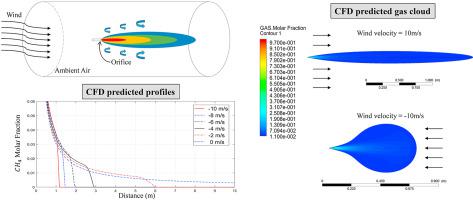Journal of Loss Prevention in the Process Industries ( IF 3.6 ) Pub Date : 2020-09-06 , DOI: 10.1016/j.jlp.2020.104278 Paloma L. Barros , Aurélio M. Luiz , Claudemi A. Nascimento , Antônio T.P. Neto , José J.N. Alves

|
Hazardous areas are defined as a result of a variety of variables as storage temperature, pressure, leak orifice size, physical properties of flammable substance, and wind characteristics. The potential formation of an explosive atmosphere must be accurately assessed to ensure process safety. Therefore, computational fluid dynamics (CFD) arises as an important tool for accurate predictions as recommended by the international standard IEC 60079-10-1 (2015). This study aims to analyze the influence of wind velocity magnitude and direction on the hazardous area classification. The authors evaluated the extent and volume for methane, propane, and hydrogen leakages from a CFD model. For each flammable gas, the wind velocity magnitude and direction were regularly varied. The outcomes show that the behavior of the plume size as the wind varies mainly depends on the gas concentration. Counter-flow wind directions lead to zero relative velocity closer to the release point, which concentrates the gas, and wind in the release direction promotes a higher dilution of the gas cloud increasing the hazardous extent while decreases the volume. As a consequence, the wind also influences the zone type, which was accurately predicted from CFD simulations and significant differences were found when compared to the standard analyses. These differences are, to some extent, related to the consideration of wind velocity effects on the gas jet release.
中文翻译:

从CFD模拟危险区域分类中非单调风对可燃气体云的影响
危险区域的定义是由于存储温度,压力,泄漏孔口大小,易燃物质的物理特性和风特性等多种变量导致的。必须准确评估爆炸性气体的潜在形成,以确保过程安全。因此,根据国际标准IEC 60079-10-1(2015)的建议,计算流体动力学(CFD)成为准确预测的重要工具。本研究旨在分析风速大小和方向对危险区域分类的影响。作者评估了CFD模型中甲烷,丙烷和氢气泄漏的程度和体积。对于每种易燃气体,风速大小和方向均定期变化。结果表明,随着风的变化,羽流大小的行为主要取决于气体浓度。逆流风向导致接近释放点的零相对速度使气体集中,而沿释放方向的风促进了气体云的更高稀释度,增加了危险程度,同时减小了体积。结果,风也影响区域类型,这是通过CFD模拟准确预测的,与标准分析相比,发现了显着差异。这些差异在某种程度上与考虑风速对气体射流释放的影响有关。释放方向上的风促进了气体云的更高稀释度,增加了危险程度,同时减小了体积。结果,风也影响区域类型,这是通过CFD模拟准确预测的,与标准分析相比,发现了显着差异。这些差异在某种程度上与考虑风速对气体射流释放的影响有关。释放方向上的风促进了气体云的更高稀释度,增加了危险程度,同时减小了体积。结果,风也影响区域类型,这是通过CFD模拟准确预测的,与标准分析相比,发现了显着差异。这些差异在某种程度上与考虑风速对气体射流释放的影响有关。










































 京公网安备 11010802027423号
京公网安备 11010802027423号